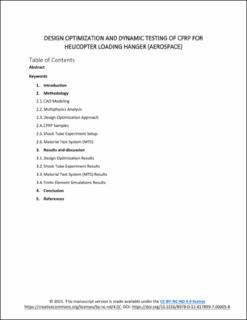| dc.contributor.author | Andleeb, Zahra | |
| dc.contributor.author | Malik, Sohail | |
| dc.contributor.author | Ghulam, Hussain | |
| dc.contributor.author | Khawaja, Hassan | |
| dc.contributor.author | Moatamedi, Mojtaba | |
| dc.date.accessioned | 2023-01-25T14:41:38Z | |
| dc.date.available | 2023-01-25T14:41:38Z | |
| dc.date.created | 2021-07-20T21:53:32Z | |
| dc.date.issued | 2021-07-23 | |
| dc.identifier.isbn | 978-0-12-817899-7 | |
| dc.identifier.uri | https://hdl.handle.net/11250/3046390 | |
| dc.description.abstract | This chapter presents the Multiphysics technique applied in the design optimization of a loading hanger for an aerial crane. In this study, design optimization is applied on the geometric modelling of a part being used in an aerial crane operation. A set of dimensional and loading requirements are provided. Various geometric models are built using SolidWorks® Computer Aided Design (CAD) Package. In addition, Finite Element Method (FEM) is applied to study these geometric models using ANSYS® Multiphysics software. Appropriate material is chosen based on the strength to weight ratio. Efforts are made to optimize the geometry to reduce the weight of the part. Further the chosen carbon fiber reinforced polymers (CFRPs) quasi-isotropic shell structures are analyzed under the influence of dynamic loading. The quasi-isotropic CFRPs shell specimens are fabricated using Multipreg E720 laminates. In this study, the dynamic loading is generated using shock waves in a shock tube experimental setup. The strain and pressure data is collected from the experiments. Additional tests are carried out using Material Test System (MTS) for both tensile and flexural response of CFRPs. Results obtained from experiments are compared with numerical simulations. The numerical simulation and experimental results are found to be in good agreement. Based on the achieved results, conclusions are drawn. | en_US |
| dc.language.iso | eng | en_US |
| dc.publisher | Elsevier | en_US |
| dc.relation.ispartof | Multiphysics Simulations in Automotive and Aerospace Applications | |
| dc.rights | Attribution-NonCommercial-NoDerivatives 4.0 Internasjonal | * |
| dc.rights.uri | http://creativecommons.org/licenses/by-nc-nd/4.0/deed.no | * |
| dc.subject | Design optimization | en_US |
| dc.subject | Geometric modeling | en_US |
| dc.subject | Finite element methods | en_US |
| dc.subject | Carbon fiber reinforced polymers | en_US |
| dc.subject | Dynamic loading | en_US |
| dc.subject | Shock waves | en_US |
| dc.title | Design optimization and dynamic testing of CFRP for helicopter loading hanger | en_US |
| dc.type | Chapter | en_US |
| dc.type | Peer reviewed | en_US |
| dc.description.version | acceptedVersion | en_US |
| cristin.ispublished | true | |
| cristin.fulltext | original | |
| cristin.fulltext | postprint | |
| cristin.qualitycode | 1 | |
| dc.identifier.doi | https://doi.org/10.1016/B978-0-12-817899-7.00005-8 | |
| dc.identifier.cristin | 1922279 | |
| dc.source.pagenumber | 187-208 | en_US |

